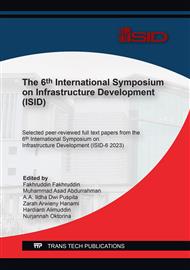[1]
M.C.G. Juenger, Advances in alter- native cementitious binders, Cem. Concr. Res. 41 (12) (2010) 1232–1243.
Google Scholar
[2]
C. Shi , New cements for the 21st century: the pursuit of an alternative to Portland cement, Cem. Concr. Res. 41 (2011) 750–763.
DOI: 10.1016/j.cemconres.2011.03.016
Google Scholar
[3]
P. Duxson, Geopolymer technology: the current state of the art, J. Mater. Sci. 42 (9) (2007) 2917–2933.
Google Scholar
[4]
J. Davidovits, Geopolymers and geopolymeric materials, Therm. Anal. Calorim. 35 (2) (1989) 429–441.
Google Scholar
[5]
A.F. Abdalqader, Development of greener alkali-activated cement: utilisation of sodium carbonate for activating slag and fly ash mixtures, J. Cleaner Prod. 113 (2016) 66–75.
DOI: 10.1016/j.jclepro.2015.12.010
Google Scholar
[6]
B. Nematollahi, Synthesis of heat and ambient cured one-part geopolymer mixes with different grades of sodium silicate, Ceram. Int. 41 (4) (2015) 5696–5704.
DOI: 10.1016/j.ceramint.2014.12.154
Google Scholar
[7]
T. Luukkonen, Comparison of alkali and silica sources in one-part alkali activated blast furnace slag mortar, J. Cleaner Prod. 187 (2018) 171–179.
DOI: 10.1016/j.jclepro.2018.03.202
Google Scholar
[8]
Darma Adis, Studi Experimental Pengaruh Perbedaan Molaritas Aktivator pada Perilaku Beton Geopolimer Berbahan Dasar fly ash, Jurnal Karya Teknik Sipil Vol 7 no 11 (2018).
DOI: 10.5614/jts.2023.30.3.6
Google Scholar
[9]
Rita Irmawaty, Experimental and analytical study for shear strengthening of reinforced-concrete beams using a prefabricated geopolymer–mortar panel, Case Studies in Construction Materials 17 (2022) e01568.
DOI: 10.1016/j.cscm.2022.e01568
Google Scholar
[10]
Fakhruddin, External Shear Strengthening of RC Beams with Anchored Geopolymer Fiber Mortar Panel: An Experimental Study, Materials Science Forum vol 1091 (2023) 93-100.
DOI: 10.4028/p-1tdbui
Google Scholar
[11]
Nur Fikri Ramdhani Arifin, The Utilization of Geopolymer Mortar as Permanent Formwork in Reinforced Concrete Beam, Materials Science Forum vol 1091 (2023) 143-149.
DOI: 10.4028/p-d8g0ka
Google Scholar
[12]
D. Setyati Budiningrum, A. Kustirini, B. purnijanto, d. mahasukma, and t. yogha utama, Studi experimental kuat tekan beton geopolimer berbahan dasar fly ash pltu tanjung jati b jepara. Majalah ilmiah pengembangan rekayasa, social dan humaniora (2021).
DOI: 10.32497/bangunrekaprima.v7i2.2997
Google Scholar
[13]
M. Sofyan, The Effect of Using Linear Low Density Polyethylene ( LLDPE ) Powder and Rice Husk Asn on Compressive Strength and Intital Setting Time of Alkaline-Activated Mortar, Earth and Environmental Science (2021).
DOI: 10.1088/1755-1315/921/1/012070
Google Scholar
[14]
A. El Mir, Durability of self-consolidating concrete containing natural waste perlite powders, Heliyon, vol. 6, no. 1, Jan. (2020) e03165.
DOI: 10.1016/j.heliyon.2020.e03165
Google Scholar
[15]
M. C. Acar, A. İ. Çelik, Production of perlite-based-aerated geopolymer using hydrogen peroxide as eco-friendly material for energy-efficient buildings, Journal of Materials Research and Technology, vol. 24, (2023) p.81–99
DOI: 10.1016/j.jmrt.2023.02.179
Google Scholar
[16]
ASTM C.33, Standard Specification For Concrete Aggregates, Annual Books Of ASTM Standards, USA (2002)
Google Scholar
[17]
ASTM C39/C39M, Standard test method for compressive strength of cylindrical concrete specimens. In American Society of Testing and Materials, (2018) Pennsylvania, USA: West Conshohocken.
Google Scholar
[18]
ASTM C496-96, Standard Test Method for Splitting Tensile Strength of Cylindrical Concrete Specimens, (2017).
Google Scholar
[19]
ASTM C143/C143M-12, Standard Test Method for Slump of Hydraulic-Cement Concrete, (2015).
Google Scholar
[20]
A. Aziz, Effect of acidic volcanic perlite rock on physio-mechanical properties and microstructure of natural pozzolan based geopolymers, Case Studies in Construction no. 15 (2021).
DOI: 10.1016/j.cscm.2021.e00712
Google Scholar
[21]
M. Rajendran, Influence of Perlite and Glass Fiber on the Compressive , Split Tensile and Flexural Strength of Concrete Incorprating Glass Fiber, IJITEE Vol 8 no. 3, (2019) 185–188.
Google Scholar
[22]
P. Muthupriya, Utilization of Industrial Waste Perlite Powder and Vermiculite in Self Compacting Concrete, IJERTvol. 9, no. 06 (2020) 782–789.
DOI: 10.17577/ijertv9is060528
Google Scholar


